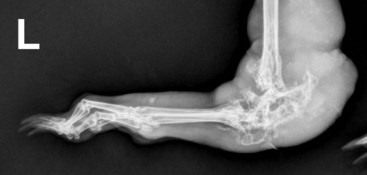• Rabbits lack fleshy footpads. They rely on a normally thick covering of hair on the plantar and palmar surfaces of their feet. The underlying skin is thin, especially in the region of the metatarsus, increasing their vulnerability to developing pododermatitis. • Thumping of hind feet displayed by some individuals may predispose to this condition. • Short-coated breeds (e.g., Rex) are predisposed owing to thin hair coverage on feet. • Large breeds: giant rabbits may also be predisposed • Hybrid meat rabbits and New Zealand white rabbits are more resistant to developing pododermatitis because of the dense hair coat on their footpads and metatarsus. • Unhygienic housing (especially damp bedding) • Iatrogenic (clipping of hair) • Abrasive substrates (e.g., wire flooring, concrete, noncompliant substrates, some carpets) • Lameness to any foot, leading to excessive weight bearing on other feet • Infection (especially Staphylococcus aureus and Pasteurella multocida) • S. aureus and P. multocida may cause or complicate pododermatitis, especially in moist conditions. • Specific high-virulence S. aureus strains do not seem to need these predisposing factors to cause disease. • High-virulence S. aureus strains belonging to a specific bacterial clone have been isolated from meat rabbits within Europe and Australia. • Rabbits lack footpads. The skin on their feet is very thin and adherent to underlying connective tissue. • Hopping involves a digitigrade gait; while at rest, the hind feet are plantargrade, and weight is shared between the hind claws and the metatarsus. • Noncompliant substrates (hard flooring) and wire floors prevent the hind feet from adopting normal plantargrade stance, causing most of the weight to be sustained by the metatarsus and hock, not by the claws. • Some abrasive surfaces (e.g., carpet) may produce friction on the skin, thus exacerbating the problem. • Ensuing abnormal weight bearing and loss of protective hair covering lead to development of pressure sores. • Ischemia and necrosis of compressed soft tissue can develop and may lead to ulcerative and erosive lesions. • Parts of the metatarsus most vulnerable include point of hock (calcaneus) and plantar prominence of central tarsal bone. The tip of each toe of any foot and the palmar carpal area can also be affected. • Occasionally, ulcerative lesions can disrupt the integrity of the medial plantar vein or artery; this can result in significant hemorrhage and anemia. • Advanced hindfoot cases can cause displacement of the superficial flexor tendon. This can cause permanent alteration of hindfoot conformation whereby toes are not able to flex appropriately, leading to extra weight bearing upon the point of the hock. • Ulcerative pododermatitis is a vicious cycle whereby pain and disability reduce mobility, thus further exacerbating the condition. • Moist and unhygienic conditions aggravate the condition, as can any condition that results in urinary and fecal soiling of the feet. • Secondary infections that occur, primarily by Staphylococcus aureus and Pasteurella multocida, can lead to osteomyelitis and synovitis, predisposing to displacement of the superficial flexor tendon. Suppurative and exudative processes can lead to local hair matting and further contamination and abnormal pressure placement. • Conditions that lead to lack of mobility (e.g., cramped housing, arthritis, spondylosis) can predispose to development of pododermatitis. • Overweight, pregnant, and emaciated rabbits are more prone to developing the condition, as are large breed (>5 kg body weight) and Rex breed rabbits. • Iatrogenic causes ensue if inadvertent removal of plantar or palmar hair occurs, or when hair is removed in preparation for surgery. • Chronic infection may lead to anemia.
Pododermatitis
Basic Information
![]()
Special Species Considerations
Epidemiology
Genetics and Breed Predisposition
Risk Factors
Contagion and Zoonosis
Associated Conditions and Disorders
Etiology and Pathophysiology
![]()
Stay updated, free articles. Join our Telegram channel

Full access? Get Clinical Tree


Pododermatitis
Only gold members can continue reading. Log In or Register to continue

